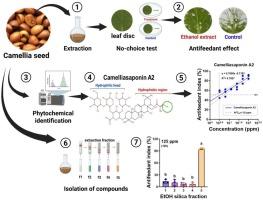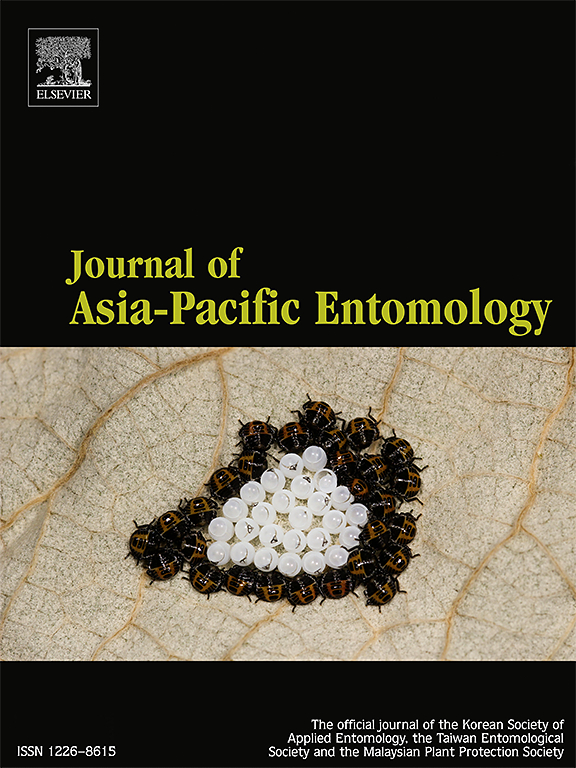从山茶种子中提取的茶花皂苷A1和A2是对小菜蛾幼虫的主要拒食化合物。
IF 1.3
3区 农林科学
Q3 ENTOMOLOGY
引用次数: 0
摘要
小菜蛾(小菜蛾)是十字花科作物的主要害虫,给全球造成了巨大的经济损失。因此,本研究旨在从山茶种子中分离出天然的拒食化合物,并评价其对小菜蛾3龄幼虫的生物活性。在被试植物提取物中,粳稻种子乙醇提取物具有较强的拒食活性,50%拒食浓度(AFC50)为128 ppm。通过LC-MS/MS分析,确定了该提取物的主要成分,包括双糖(17%)、山奈酚苷(12%)、茶花皂苷A1(10%)、茶花皂苷A2(11%)和其他三萜苷。随后的中压液相色谱(MPLC)对提取物进行分离,得到5个部分,其中一个部分在125.0 ppm时显示出拒食活性。该活性组分含有高水平的茶花皂苷A1(5,031±286 ppm)和A2(6,053±185 ppm)。原产茶花皂苷A1和A2对小菜蛾幼虫也表现出较强的拒食活性,其AFC50值分别为5.4 ppm和3.6 ppm,均低于印楝素(AFC50 = 12.4 ppm)。这些结果证实了茶花皂苷A1和A2是粳稻种子提取物中主要的抗食性活性成分。总的来说,这些发现突出了山茶籽提取物开发成针对鳞翅目幼虫的环境友好型害虫综合治理制剂的潜力。本文章由计算机程序翻译,如有差异,请以英文原文为准。

Camelliasaponins A1 and A2 extracted from camellia (Camellia japonica var. japonica) seeds are key antifeedant compounds against the larvae of diamondback moth (Plutella xylostella L.)
Plutella xylostella (diamondback moth) is a major pest of cruciferous crops, causing substantial global economic losses. Therefore, this study aims to isolate natural antifeedant compounds from Camellia japonica seeds and evaluate their bioactivity against third-instar larvae of P. xylostella. Among the tested plant extracts, the ethanolic extract of C. japonica seeds exhibited strong antifeedant activity, with a 50 % antifeedant concentration (AFC50) of 128 ppm. LC-MS/MS analysis of the extract identified major constituents, including disaccharides (17 %), kaempferol glycosides (12 %), camelliasaponin A1 (10 %), camelliasaponin A2 (11 %), and other triterpenoid glycosides. Subsequent medium-pressure liquid chromatography (MPLC) fractionation of the extract produced five fractions, one of which showed antifeedant activity at 125.0 ppm. This active fraction contained high levels of camelliasaponins A1 (5,031 ± 286 ppm) and A2 (6,053 ± 185 ppm). Authentic camelliasaponin A1 and A2 also showed potent antifeedant activity against P. xylostella larvae, with AFC50 values of 5.4 ppm and 3.6 ppm, respectively—both lower than that of neem-derived Azadirachtin (AFC50 = 12.4 ppm). These findings confirm that camelliasaponins A1 and A2 are the principal active antifeedant constituents in C. japonica seed extracts. Overall, the findings highlight the potential of camellia seed extracts for development into environmentally friendly formulations for integrated pest management targeting lepidopteran larvae.
求助全文
通过发布文献求助,成功后即可免费获取论文全文。
去求助
来源期刊

Journal of Asia-pacific Entomology
Agricultural and Biological Sciences-Insect Science
CiteScore
2.70
自引率
6.70%
发文量
152
审稿时长
69 days
期刊介绍:
The journal publishes original research papers, review articles and short communications in the basic and applied area concerning insects, mites or other arthropods and nematodes of economic importance in agriculture, forestry, industry, human and animal health, and natural resource and environment management, and is the official journal of the Korean Society of Applied Entomology and the Taiwan Entomological Society.
 求助内容:
求助内容: 应助结果提醒方式:
应助结果提醒方式:


